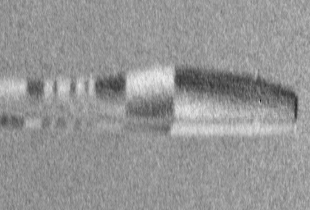The conceptual proposal for a so-called race-track three-dimensional data storage device based on domain walls in a dense array of vertical wires, revived the attention on cylindrical magnetic nanostructures. While mostly nanowires have been considered so far, nanotubes, i.e. a shell with an empty core, would open the door to core-shell structures, whose interfaces could be used to implement various spintronic effects. Here we report the development of a new building block: a material with azimuthal anisotropy based on electroless deposition, yielding flux-closure domains in tubes.
The common route for the fabrication of long cylindrical structures is deposition in a sacrificial template displaying pores, such as anodized aluminum or polycarbonate irradiated foils. Electroplating is the usual route to fabricate wires. Bath composition and plating parameters can be tuned to yield tubes, however the conditions are often critical to control. Instead, we used electroless plating. This is an in-solution conformal chemical synthesis, which unlike atomic layer deposition is suitable to deposit directly 3d magnetic metals Fe, Co, Ni and their alloys. We targeted Fe20Ni80 and Co20Ni80, known to be soft magnetic materials, while boron is also included to some extent, being the reducing agent used. The present tubes had a length of 30 µm, diameter 350 nm, and shell thickness of a few tens of nm. The templates were dissolved and the tubes laid on a supporting surface for further investigation.
We inspected these tubes using the high-spatial-resolution magnetic microscopy technique XMCD-PEEM and STXM at the French SOLEIL and Italian ELETTRA synchrotron facilities. This way, we provided the first images of well-defined domains and domain walls in magnetic nanotubes. Surprisingly, in the case of (Co20Ni80)Bx magnetization curls around the tube axis in a flux-closure fashion, the changing sign of circulation defining domains, while for anisotropic and very long objects such as our tubes, axial magnetization is expected. We believe, this results from an anisotropic strain between the azimuthal and axial directions, resulting from the inward radial growth. Indeed, the less magnetostrictive alloy (Fe20Ni80) Bx displays axial magnetization.
In terms of physics, the well-defined domain walls and the various possible directions of magnetization of these materials provide a toolkit to investigate domain-wall motion in tubes in the future, which so far have only been considered theoretically. In terms of functionality, the flux-closure (Co20Ni80)Bx material provides a mean to greatly decrease the considerable dipolar interactions existing between domain walls in wires, which are of head-to-head or tail-to-tail type, thus unavoidably associated with a magnetic charge.
10×1.5 µm magnetic image of a (Co20Ni80)Bx nanotube using the synchrotron-based shadow XMCD-PEEM technique.
The wire appears at the bottom of the image, while the above part is the shadow, whose light/dark contrast reveals the curling of magnetization around the tube axis. The contrast alternation along the tube axis reveals domains with opposite sign or curling.
Team: Spin textures
Collaboration: Institut Néel, Univ. Darmstadt (Pr. W. Ensinger), Synchrotrons SOLEIL and ELETTRA.
Funding: Labex LANEF (Grenoble).
Further reading: Imaging magnetic flux-closure domains and domain walls in electroless-deposited CoNiB nanotubes, M. Staňo, S. Schaefer, A. Wartelle, M. Rioult, R. Belkhou, A. Sala, T. O. Menteş, A. Locatelli, L. Cagnon, B. Trapp, S. Bochmann, S. Martin, E. Gautier, J. C. Toussaint, W. Ensinger, O. Fruchart, SciPost Phys. 5(4), 038 (2018).
DOI: 10.21468/SciPostPhys.5.4.038
Contact: olivier.fruchart@cea.fr

